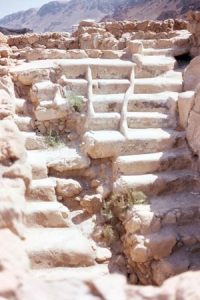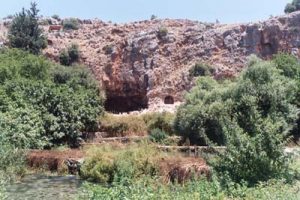by Rev. Ed Visser
My people have committed two sins: They have forsaken me, the spring of living water, and have dug their own cisterns, broken cisterns that cannot hold water. – Jeremiah 2:13
“Drink lots of water,” we were told. “Sip it constantly, 3 – 5 liters a day.” It didn’t take long to discover why. Israel is a desert culture; nothing is more precious than water. Maybe that’s why Bible authors often use water imagery — even for God!
Early on our trip, we sat by one of the sources of the Jordan River at Dan. Here there are 17 spots where the water comes out from Mount Hermon in springs, joining together to form a rapidly flowing river. The Jordan flows south into the Sea of Galilee, then it continues south until it empties into the Dead Sea.
In Jeremiah’s prophecy, God uses the spring as an image for himself. And for good reason. A spring produces water year-round, while all other water supplies are temporary or seasonal. Throughout the desert one can see hundreds of wadis, large and small, which flow with water  during the rainy season, but are dry riverbeds the rest of the year. To keep a steady water supply when not near a spring, people constructed cisterns from rock, plastering the insides. But these held tepid, often polluted water, when they were in good repair. …
during the rainy season, but are dry riverbeds the rest of the year. To keep a steady water supply when not near a spring, people constructed cisterns from rock, plastering the insides. But these held tepid, often polluted water, when they were in good repair. …
Cisterns were useless, of course, when cracked from heat or usage. Springs, on the other hand, produced “living water” — water directly from the hand of God. Regardless of the season or location, the spring brought life in a “dry and weary land.”
Similarly, God is “living water” for our lives, much more like the spring at Dan, the headwaters of the Jordan, than the end of the Jordan, the Dead Sea. The water at Dan was fresh, cool and clean; we even drank from them. But drinking any quantity of the Dead Sea waters would cause rapid illness and even death.
God is also a constant spring, not a seasonal wadi. Yet his people have not only left him, the living water, but they’ve also forsaken him to build their own cisterns. Spiritually they’ve carved out a reservoir which they can control. Sometimes we develop a “cistern relationship” with God. We try to get along without Him, do it our own way, until we get dry and need refilling. Even a short time in the land will convince you how ludicrous it is to forsake “living water” — life itself!




